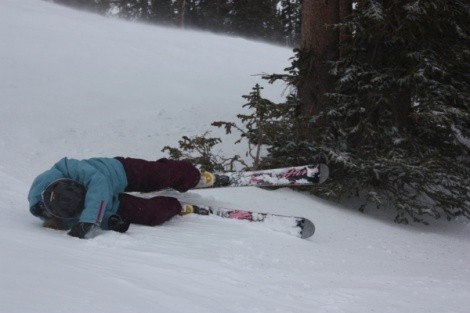
It’s easy to get into trouble on the mountain. I’m not talking about apres ski; you’re on your own there—aside from this important caveat: Never do anything that will make you hate yourself in the morning.
On the actual slopes, trouble can come without warning, especially on an unfamiliar trail or with less experienced skiers and snowboarders. Some situations are so common that you’ve probably already experienced them. Here are a few ways to get out of danger on the mountain, whether you’re on a board or skis.
First, a true story: Years ago, I had an afternoon speaking engagement in Ogden, so it seemed like a great idea to grab a few morning runs at Snowbasin—a resort with which I was not familiar at the time. I skied to the Strawberry lift, but it was closed. Behind the lift was what looked like a trail. Assuming (wrongly) that the lift served that terrain, I started down the trail. But after about five minutes of peaceful skiing, the “trail” faded away. I was in forest terrain, with no idea where to go. My phone was in the car, yelling for help brought no response, and when I took off my skis to hike up the miles to the lift, I sunk above my boot tops into unpacked snow. Walking back up the mountain would be impossible.
What saved me was the speaking engagement. Getting to it on time was the only thing on my mind, and it was that focus that kept panic at bay. Figuring that going downhill would eventually lead to a road, I kept moving with determination, so fear didn’t take control. Finally, the road appeared. Holding skis and poles, I hitched back up to the resort—eight miles away. After a quick clothing change, I drove to the engagement, arriving just 10 minutes late.
It was a learning experience. The lessons were: If you’re hitting the lifts, don’t leave your cell phone in the car. Never assume anything about an unfamiliar trail; ask where it leads before taking it, especially if the snow is fresh and avalanche danger is high. If you’re lost and have no way to contact a rescuer, carefully head downhill.
Most importantly: Panic will always make a bad situation worse. For example, if you stiffen up and lean back in panic because you’ve hit a patch of ice, you’ll go down. The solution to surviving ice is to relax and ride it out. Within a second or two, you’ll be back on carvable snow, and can use your edges to slow down.
Another common situation, especially for non-experts: You’re suddenly on terrain too steep to handle. The solution is to ride across the trail, turn, then ride across again at a manageable downhill angle. Steepness is eliminated when a trail is used horizontally instead of vertically.
Moguls are problematic for many snowriders. But a moguled trail will always be less bumpy away from the middle. Go to the sides of the trail to get away from the bumps.
A potentially lethal situation happens when a snowrider is out of control and heading toward trees or rocks. If you’ve lost traction and are heading toward something that can hurt you, quickly drop to one side, with your feet toward the object of impact. Dig in your edges to slow your speed and, ideally, you’ll come to a stop. It’s a good idea to practice this on a soft snow day, so you have the move wired if you ever need it.
Unlike snowboarders, skiers can lose their gear. Spending a powder day searching for a lost ski is a bummer. Prevent it with a cheap roll of red ribbon from a fabric or craft store. Cut off two 12-foot lengths. At the lift, tie each length of ribbon to a ski brake and stuff the rest of the ribbon under your snow pants. If a ski comes off, the ribbon acts like a powder cord, allowing you to instantly locate it and resume your day on the freshies.